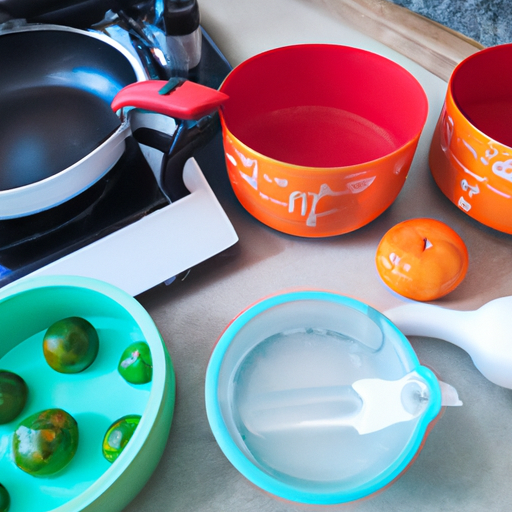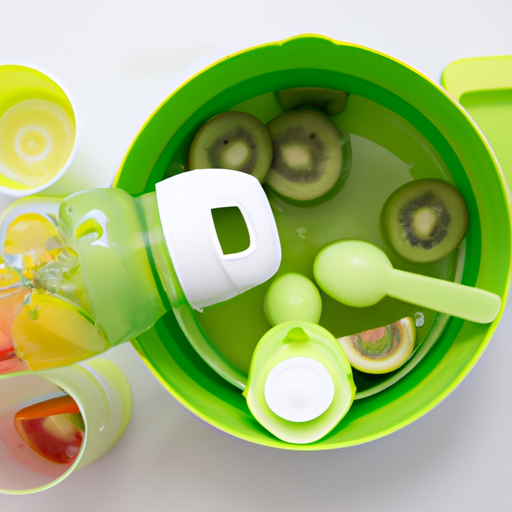Make Your Own Homemade Baby Food – Fruits Stage 2
Introducing Baby Food Fruits for Stage 2
Once your little one has gotten the hang of solids and is at least six months old, it’s time to broaden her culinary horizons. It’s time to introduce baby food fruits for stage 2! This phase is all about new tastes, textures, and delicious discoveries. As always, follow your baby’s lead. Respect her pace and ensure she is comfortable with simple solids before venturing into new territory.
Introducing new flavors can sometimes require gentle persistence. Remember, it’s not a race, so never force feed your little one. It’s important to know that it can often take five or more tastes before a baby warms up to a new food. The more flavors you introduce, the more adventurous their palette will become.
At this stage, while still avoiding added salt and excess sugar, you can begin to incorporate fresh herbs or mild spices into baby food. Be vigilant for any adverse or allergic reactions. After introducing fruits and vegetables, you can start combining them. The possibilities for tasty mixtures are limitless with the wide variety of fruits and vegetables available.
No-Cook Tropical Fruits
Here’s a quick and easy no-cook recipe to kickstart your baby’s tropical adventure:
- 2 Kiwifruit, peeled and quartered
- 1 Papaya, peeled, seeded, and chopped
- 1 ripe Banana, peeled and cut into 1/2 inch thick slices
Just place the fruit in a food processor and process until smooth. This recipe yields about 2 cups or 8 (1/4 cup) servings.
Apples, Pears, & Plums Delight
Here’s another recipe that’s a delightful blend of apples, pears, and plums:
- 2 ripe Pears, peeled, cored, and quartered
- 1 large Golden Delicious Apple, peeled, cored, and quartered
- 2 Plums, peeled, halved, and pitted
Place the pear and apple in a vegetable steamer and steam for 8 minutes. Add the plums and continue to steam for an additional 4 minutes or until all the fruit is tender. Then, place the fruit in a food processor and process until smooth. This recipe also yields about 2 cups or 8 (1/4 cup) servings.
Blueberry Banana Yogurt
This Blueberry Banana Yogurt is a tasty and nutritious option for your baby:
- 1 cup Blueberries
- 1 whole Banana
- 1 cup plain Yogurt
- 2 tablespoons Wheat Germ
Use 1 cup of your pre-made blueberry puree or microwave the blueberries until the juices start to run (about 30 seconds). Place the banana, yogurt, and blueberries in a blender and puree until smooth.
Other delightful combinations to try include:
- Prune & Banana
- Papaya & Mango
- Pear & Prune
Also, don’t miss these veggie & fruit combinations:
- Apples & Butternut Squash
- Squash & Peach
- Avocado & Banana
- Sweet Potato & Apricot
- Sweet Potato & Peach
Introducing baby food fruits for stage 2 is an exciting culinary journey for both you and your little one. It’s the start of a lifelong adventure of flavors and healthy eating habits. Enjoy this journey, and remember, every baby is unique, so be patient, persistent, and creative with your baby food recipes!
This post may contain affiliate links which fund the My Sparkling Life blog.
| Recipe Name | Ingredients | Instructions |
|————-|————-|————–|
| No-Cook Tropical Fruits | 2 Kiwifruit, peeled and quartered, 1 papaya, peeled, seeded, and chopped, 1 ripe banana, peeled and cut into 1/2 inch thick slices | Place fruit in a food processor; process until smooth. Yield; 2 cups or 8 (1/4 cup) servings |
| Apples, Pears, & Plums | 2 ripe pears, peeled, cored, and quartered, 1 large golden delicious apple, peeled, cored, and quartered, 2 plums, peeled, halved and pitted | Place pear, and apple in a vegetable steamer. Steam covered for 8 minutes. Add plums; cover and steam an additional 4 minutes or until all fruit is tender. Place fruit in a food processor; process until smooth. Yield; 2 cups or 8 (1/4 cup) servings |
| Blueberry Banana Yogurt | 1 cup blueberries, 1 whole banana, 1 cup plain yogurt, 2 tablespoons wheat germ | Use 1 cup of your already made blueberry puree OR Microwave the blueberries just until the juices start to run, about 30 seconds. Place the banana, yogurt and blueberries in a blender and puree until smooth. |
| Other combos to try | Prune & Banana, Papaya & Mango, Pear & Prune | – |
| Veggie & Fruit Combos to try | Apples & Butternut Squash, Squash & Peach, Avocado & Banana, Sweet Potato & Apricot, Sweet Potato & Peach | – |

Understanding Stage 2 Baby Food Fruits
Stage 2 baby food is typically introduced when your little one is between 6 to 8 months old. The biggest difference between stage 1 and stage 2 baby food is the texture. While stage 1 foods are pureed to a smooth consistency, stage 2 foods are slightly thicker and may include small, soft chunks. This transition helps your baby learn to chew and swallow more complex textures.
Furthermore, stage 2 foods can contain combinations of ingredients, including fruits mixed with grains, vegetables, or proteins. This helps introduce your baby to a wider variety of flavors, and can help them learn to enjoy different food combinations.
Benefits of Introducing Baby Food Fruits in Stage 2
Introducing baby food fruits in stage 2 has numerous benefits. Firstly, fruits are packed with essential vitamins and minerals that support healthy growth and development. Secondly, fruits are generally sweet and palatable, making them a great way to introduce your baby to new flavors. Lastly, the varied textures of fruits help your baby develop their chewing and swallowing skills.
Choosing the Right Fruits
When it comes to selecting fruits for your baby’s stage 2 diet, opt for fruits that are ripe and fresh. Some popular choices include bananas, apples, pears, plums, peaches, avocados, and berries. Avoid fruits with a high acidity level, such as citrus fruits, as they can cause stomach upset and diaper rash.
Preparing Stage 2 Baby Food Fruits
Preparing stage 2 baby food fruits is quite simple. You can either mash the fruit with a fork for a chunkier texture or puree it in a food processor if your baby isn’t ready for lumps yet. Always ensure the fruit is thoroughly washed and peeled, and remove any seeds or pits. If you’re using a fruit that tends to brown, such as apples or pears, a bit of lemon juice can help prevent oxidation.
Safe Introduction of New Fruits
When introducing any new fruit to your baby, it’s best to follow the “four day rule”. This means introducing one new fruit at a time and waiting four days before introducing another. This allows you to monitor your baby for any potential allergic reactions, such as rash, diarrhea, or vomiting.
Storing Baby Food Fruits
Homemade baby food fruits can be stored in the refrigerator for up to 48 hours. For longer storage, freeze the puree in ice cube trays, then transfer the cubes to a freezer bag. Each cube is approximately one serving, making it easy to defrost the exact amount you need.
Frequently Asked Questions
What fruits should I avoid in stage 2?
You should avoid citrus fruits and strawberries due to their high acidity level and potential allergenic properties. Also, avoid fruits with tough skins or seeds that could pose a choking hazard.
Can I use canned fruits for baby food?
While fresh fruits are always the best choice, canned fruits can be used as long as they are packed in water or their own juice, not syrup. Ensure they do not contain added sugars or preservatives.
Can I add spices to my baby’s fruit puree?
Yes, adding a small amount of mild spices like cinnamon or nutmeg can enhance the flavor of the fruit puree. However, always introduce spices one at a time to monitor for any potential allergic reactions.
Remember, always consult with your pediatrician when introducing new foods to your baby’s diet. Happy feeding!
1. What is Stage 2 Baby Food?
Stage 2 baby food is the second step in baby’s transition from breast milk or formula to solid food. This stage typically starts around 6 months of age and includes pureed fruits and vegetables with more texture and flavor variety than Stage 1 foods.
2. When should I start introducing Stage 2 baby food fruits?
Stage 2 baby food fruits can be introduced once your baby is at least six months old and has gotten comfortable with simple solids.
3. How can I introduce new fruit flavors to my baby?
Introducing new flavors can sometimes require persistence. It’s important to know that it can often take five or more tastes before a baby warms up to a new food.
4. Can I add spices or herbs into my baby’s food at Stage 2?
Yes, at this stage, you can begin to incorporate fresh herbs or mild spices into baby food. However, you should always be vigilant for any adverse or allergic reactions.
5. Can I combine fruits and vegetables in Stage 2 baby food?
Yes, after introducing fruits and vegetables, you can start combining them in Stage 2 baby food.
6. What are some easy recipes for Stage 2 baby food fruits?
Some easy recipes include a No-Cook Tropical Fruits mix made of kiwi, papaya, and banana, an Apples, Pears, & Plums Delight and a Blueberry Banana Yogurt.
7. What are some good fruit combinations for Stage 2 baby food?
Some delightful fruit combinations to try include Prune & Banana, Papaya & Mango, and Pear & Prune.
8. What are some good veggie and fruit combinations for Stage 2 baby food?
Some good veggie and fruit combinations include Apples & Butternut Squash, Squash & Peach, Avocado & Banana, Sweet Potato & Apricot, and Sweet Potato & Peach.
9. What should I remember when introducing baby food fruits for Stage 2?
Remember, every baby is unique, so be patient, persistent, and creative with your baby food recipes. Also, never force feed your baby and be sure to watch for any adverse or allergic reactions.

